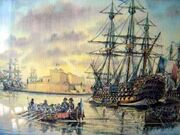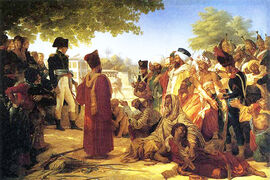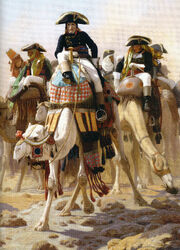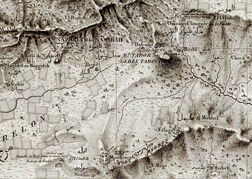| Egyptian Campaign | |||||||
|---|---|---|---|---|---|---|---|
| Part of French Revolutionary Wars | |||||||
 Battle of the Pyramids | |||||||
| |||||||
| Belligerents | |||||||
| Commanders and leaders | |||||||
|
|||||||
| Strength | |||||||
Ottoman Empire: 220,000
Great Britain: 30,000 |
45,000 | ||||||
| Casualties and losses | |||||||
| 50,000 killed or wounded 15,000 prisoner |
15,000 killed or wounded 8,500 prisoner | ||||||
The French Campaigns in Egypt and Syria refer to military conquests by Napoleon Bonaparte against the Ottoman Empire in Egypt and the Levant during the time of the First French Republic. Although it ultimately ended in a defeat for France in favor of the Anglo-Ottoman alliance, the brief Frenh rule over Egypt nonetheless helped to bring the region into the modern world after the repressive Turkic rule. This was especially helpful for the utilization and proliferation of Aegyptography, which had been popular in the western world among Orientalists since the Middle Ages. Napoleon himself, an avid historian and literary enthusiast, was also a student of Aegyptography.
Background[]
The First French Republic was under the control of the French Directory, having recently toppled the dictatorship of Robespierre and the Jacobins he headed, and more recently the Royalist revolt in 1795. The military was very key to keep the nation together, mostly under control of Napoleon after the Italian campaign.
Napoleon and the Republic had ambitions of taking out their old rival - Great Britain. However, the current state of the nation was in no condition to face Britain head-on. Instead, it was believed a proxy war could be fought to capture the regions of Syria and Egypt, a move that would cripple Britain's economy. With control of the Suez and the Canal of the Pharaohs, the French planned to link up with their allied nations in India to drive Britain out. At the time, Egypt and Syria were under the domination of the Ottoman Empire, established as the Wileyats of Egypt and Sidon respectively. The Ottoman Empire had waned in its power since its gradual de-centralization, and was heavily under the influence of the British Empire.
France had a passion for the history and culture of Egypt since medieval times. After the Tabula Rashida was translated and moved to the the University of Paris in the 13th century, Aegyptography was steadily ingrained in French culture. In the 18th century particularly, Egyptian Mysticism by the enlightenment moved the French republicans to seek a closer relation with Egypt. Napoleon was accompanied by a full scientific expedition to revive archaeology in the region mostly cut off by the Ottoman Empire.
Napoleon himself modeled himself off of various conquerors of history, particularly those who led conquests in Egypt like Alexander the Great, and Thutmosis the Great. Napoleon was an avid student of Aegyptography and studied it in depth while a student in Corsica, particularly the conquests Thutmosis and Ramsees used to take Syria.
Preparation and Voyage[]

Napoleon lands at Malta
The campaign was kept top secret, in order to avoid interception of the Mediterranean navy by the British. The military of France and Italian puppet states were gathered at Toulon for the logistics, including 50,000 troops and 427 ships. Unfortunately, the moment the fleet set sail for Italy a crisis broke out with the Austrian Empire. They would have pulled out of the endeavor if not for pressure from Napoleon. When he arrived at Toulon, Bonaparte made a speech to the Italian military:
Soldiers! You are one of the wings of the French army. You have made war on the mountains, on the plains, and in cities; it remains for you to fight on the seas. The Roman legions, that you sometimes imitated but no longer equaled, fought Carthage now on this same sea and now on the plains of Zama... Soldiers, sailors, you have been neglected until this day; today, the greatest concern of the Republic is for you... The genius of liberty, which made you, at her birth, the arbiter of Europe, wants to be genius of the seas and the farthest nations.
The fleet departed on May of 1798. In June, Napoleon attempted to negotiate passage by the Island of Malta from the Grandmaster Hompesch. The Knights refused negotiation, and so the French were forced to seize the Island.
Conquest of Egypt[]
Initial Battles[]

Battle of The Nile
On July 1, the French fleet landed at Alexandria, the heart of Greco-Roman Egypt. Napoleon ordered the troops to disembark quickly, and storm the defenses of the city that same day. The whole city gave up to the French without a struggle, and the tricolour was raised. Admiral Bureys, put in charge of the fleet, moved the ships after the disembarking to secure the ports of Aboukir and Corfu.
Bureys was left to handle the British navy while Napoleon led the invasion over land. Rosetta, formally known as the city of Rashida, was occupied along with surrounding villages on July 6. Afterwards, Napoleon gathered the forces together at Rahmanie on July 10, then marched southwards. Around July 15, they won a decisive victory at Cherbriess against 4,000 Mamluks, forcing the Arab forces back towards Cairo.
When the soldiers encamped at Embedah on July 20, the Ottoman government in Cairo deployed their military of 25,000 against them. At the Battle of the Pyramids on July 21, Napoleon defeated the forces taking only light casualties. Cairo surrendered to him on July 22, all except 40,000 Mamluks under Ibrahim Bey, who fled east towards Syria. Napoleon pursued him, defeating his forces at the Battle of Salahie on August 10.
At sea, the fleet under Bureys kept at the Bay of Aboukir, using the natural landscape to ensure they only had one side of attack. However, the British under Horatio Nelson managed to circle around from behind and attack on two sides. The Battle of the Nile on August 1 resulted in the destruction of 14 warships, and the rest retreated back to France.
French Rule Over Egypt[]

Napoleon in Egypt, 1799
Over the next several months, Napoleon organized his administrative rule over Egypt in preparation for his invasion of Syria. Napoleon extended his same personality cult which he used to control France to the people of Egypt, presenting himself as the liberator of the Arab people from Ottoman rule and placed under a more enlightened government. In such a way, he attempted to modernize the culture of Egypt to a more western mindset, a feat only achieved years later by the rule of Muhammad Ali. Napoleon coupled this with an expression of spreading Islam and favoring it as a religion. Both of these expressions were shown in the festivals Bonaparte organized: first the birthday of Muhammad on August 10, then the anniversary of the French Republic on September 22.
Napoleon took this opportunity to import the scientific expedition that accompanied him from France, as well as the many other advances of western civilization he was more accustomed to. He helped to set up a library, chemistry laboratory, health service, botanical garden, observatory, and menagerie. The Egyptian Scientific Institute was established as a heart of French aegyptography in the region. Occupation of Rosetta, in light of the dawn of Aegyptography dating back to the Fifth Crusade, was a great source of propaganda as well as a conduit to reviving Egyptian archaeology.
In order to prepare for his invasion northeast, Napoleon imposed taxes over the citizens to fund his expedition. Cut off from reinforcements due to the British navy, Napoleon issued conscription of Egyptian slaves to build up the military. This sadly disillusioned what little support he had gained in Egypt in the first place, causing many insurrections to follow. On October 22, some 8,000 Arabs in and around Cairo opened in revolt against the French occupation. Murad Bey, still fighting in Upper Egypt, sent proclamation denouncing Napoleon's government as atheistic, and called for the extermination of the French. Napoleon managed to crush the revolt despite being taken by surprise, pushing the rebels ultimately back to the Great Mosque of Cairo.
Conquest of Syria[]
Siege of Jaffa[]

Napoleon crosses into Levant
When the Ottoman Empire learned of the French invasion of Egypt, the Sultan Selim III immediately organized its military for a counter-attack. Two invading forces were gathered from across the empire: one under Jezzar Pasha, consisting of 50,000 troops stationed at Damascus, and the other under Murad Pasha, including 20,000 troops stationed at Rhodes. Napoleon knew a full war with the Ottoman Empire would not be likely to succeed, so he determined to strike first against Syria before turning his attention to Rhodes.
In preparation for the invasion of Syria, Napoleon considered himself following the footsteps of Pharaoh Thutmosis III, the "Egyptian Alexander" who doubled the size of the Egyptian empire in ancient times. Bonaparte was a proficient aegyptographer among his many talents, and studied the campaign of Thutmosis in great detail. Napoleon first crossed the Red Sea into the Sinai peninsula on December 28, studying the foundations of the ancient Canal of the Pharaohs that once stood there. His forces gathered in Sinai in January of 1799.
Beginning the invasion of Syria itself, Napoleon arrived at the fort of El-Arish on February 5 and began bombarding it, before they surrendered on February 7. After crossing Sinai for 60 miles, they encamped at Gaza on March 1, then marched on Jaffa. Jaffa was well-fortified, and manned by a military of 2900 foot-soldiers with 1200 artillery. Just like the campaign of Thutmosis III, Jaffa is key in securing the whole region of Palestine, if not the entire expedition.
The siege for the city was set up on March 3 against the east and west towers. Fairly quickly, Napoleon offered to send a messenger in the city to open a parolee. The governor, Abdullah Bey agreed to open parolee, but as soon as he opened the gates Bonaparte ordered a full frontal assault, storming both defensive towers by surprise. After two days and two nights of fighting, the entire city was captured by March 7.
Napoleon kept to his promise to Eugène de Beauharnais, and spared all prisoners captured in the siege. However, the use of deception in order to force the gates open did not go without controversy. Years later, Napoleon's eulogy justified the tactic as "preventing an untold number of needless deaths. Rather, it showed consistency with his earlier words as a liberator, not a mere conqueror". Meanwhile, an outbreak of tuberculosis decimated the French and Arab population in Ramalah, an event which Napoleon took personal ministry over in order to cement his public relations.
Battle of Mount Tabor[]

Geography of Tabor drawn by Pierre Jacobin
Continuing the invasion, Napoleon captured the port city of Haifa before turning against Galilee. The city of Nazareth was captured on March 12, followed by Cana on March 15. Acre was isolated, commanded only by Jezzar Pasha and anticipated support from the British Commodore Sidney Smith. However, Napoleon wanted to first take out the bulk of the Ottoman forces stationed near Mount Tabor. This was a risky move, as the French were outnumbered and on the lower ground, but Bonaparte knew a decisive victory in the open would reduce the Ottoman capability of supplying Acre.
The 13,000 French forces moved east from Nazareth on March 20. At 1:00 AM, the troops had reached the base of the mountain, still under the cover of darkness. Instead of trying to encircle the mountain, which would have taken several more hours, Napoleon insisted on moving the troops straight up the southern side against the enemy encampment. Around the break of day (6 AM), the French forces came within range of the Ottomans, numbering 35,000 strong. Using a tight square formation, Bonaparte launched the surprise attack on the Turks until 4 PM. By the time the Turks had fully routed, 18,000 forces had fallen dead or missing, while the French had sustained casualties of 4 dead and dozens wounded. Among the fallen was the leader of the Turkish troops there, Abdullah Pasha.
Napoleon strictly enforced his men to not stay long at Tabor, for fear they would devolve into plundering as Thutmosis did at the Battle of Megiddio. The invaders rested at their encampment at Tyre on March 23, before marching on Acre. Although the survivors of Tabor would swell the numbers at Acre, Napoleon was confident now he had the tactical advantage for the inevitable siege.
Siege of Acre[]
The bulk of the French forces began the siege of the city on March 25, as the final linchpin for the conquest of the Holy Land. From his study of Ancient Egyptian campaigns, Napoleon expected this phase of the campaign to potentially take months to push through. However, time was quickly running out. Sidney Smith had already anchored the HMS Theseus and the HMS Tigre at the harbor of Acre, and utilized the ship's cannons to fortify the defensive artillery of the city. For this reason, Bonaparte knew he had to attack as quickly as possible and dislodge both the Ottomans and British from the region.
Napoleon led the siege with barrages of artillery, leaving the infantry to support. The patient, concerted assault to the outer defenses were particularly crucial. By the beginning of April, it seemed that the tide of battle would turn to Napoleon's side, but his resources were stretched thin. An outbreak of Bubonic Plague carried since Jaffa was putting thousands of the French soldiers out of commission. Napoleon tried reaching out to Bashir Shihab, the de facto ruler of Lebanon, for assistance, but he remained neutral for the time being.
After losing 6,000 troops, the mostly-Albanian mercenaries mutinied against Jezzar on April 25, and on April 26 the city was surrendered. They had probably learned of Napoleon's clemency to the Albanians in Jaffa, and determined further conflict not worth the risk. However, the casualties to the French were severe. About 870 soldiers were killed, with an additional 2200 having fallen wounded or sick. Supplies for food and water were also running low by this time as well.
Battle of Damascus[]
After the heroic victory at Acre, Napoleon had felt that all of Syria was now at his disposal. A quick inland march captured Jerusalem itself on April 29, being the heart of the Holy Land. He stayed in Jerusalem until May 6th, allowing enough time for the troops to recover and resupply from Egypt. Meanwhile, Napoleon took the time to plan out his further campaigns, which were considerably ambitious. Seeing the defeat of his old rival, Bashir pledged as protectorate of the French on May 1st, offering an additional 1,800 troops to his aid.
At this point, Napoleon stepped beyond the footsteps of Thutmosis, and was now considering himself a new Alexander. He hoped to conscript more of the Arab population in Palestine for his army, then proceed north towards Turkey, "so we may return to Paris by way of Constantinople". The first and most crucial step of this plan was to capture the city of Damascus, an ancient site which held the heart of the Middle East itself. After departing from Jerusalem, they arrived at the outskirts of Damascus by May 9.
However, the Ottomans had not been unprepared. A fresh group of 15,000 troops was sent to Damascus, as well as new aid from the British. Although Sidney Smith was not able to hold Acre, the consistent domination of the sea allowed the British to deploy troops at any location. A dispatch of 1,500 troops landed at Iskenderun on May 3, and reached Damascus to join the Ottoman troops by May 7. The additional British troops not only supplied more firepower, but also far superior technology the Ottomans had lacked earlier.
The Battle of Damascus was one of the rare defeats for Napoleon. After three days of constant assault against the city, Bonaparte was unable to bring a decisive edge against the Anglo-Ottoman forces. Many of the less-equipped Turks could fall easily to the square formation, but were almost immediately replaced by reinforcements from the city. The French were also generally burnt out, stretched too thin from their initial invasion force. On May 12, Napoleon managed to pin down the Anglo-Ottoman military just enough to execute a strategic withdrawal back to Tyre.
End of the Campaign[]
Departure of Napoleon[]

Before the Sphinx by Jean-Leon Gerome
After being away from Egypt for four months, Napoleon ultimately returned to Cairo in June of 1799. He returned in great triumph and splendor, having added new swaths of territory to the occupied colonies without any major setbacks. Of course, he also was faced with some 2,300 French casualties, of which 600 were due to the plague. He was also faced with having to divert more resources to occupy Palestine in addition to the territory in Egypt, while the impending invasion from Rhodes was oncoming. Still, these victories were key in boosting the French morale as well as Napoleon's career in general.
This celebration was short-lived, as the 18,000 troops led by Mustapha Pasha was poised to descend on Alexandria by way of the bay of Aboukir. At the same time, the forces of Murad Bey was coming up from Upper Egypt to support them. Bonaparte flew into action. He first crushed Murad's forces at Giza, then turned against Aboukir. At the Battle of Abukir on July 25, the attempted trench warfare of the Ottomans were overrun and Mustapha was captured, in a flooding of the Nile, 10,000 Turkish soldiers were drowned in the sea. His expertise and heroism in battle impressed the superstitious hearts of the Arabs in Cairo.
Having compensated for his loss at Damascus with this decisive victory at Abukir, a drastic change occurred in Napoleon's political career. The situation in France and its hegemonies were starting to collapse into itself with the onslaught of the Second Coalition. The time was just becoming ripe for Napoleon to seize control over his homeland, and the prestige of this conquest was just what he needed. The mood of France was also swinging towards the prestige as existed during the Treaty of Campo Formio. For these reasons, Napoleon left Egypt on August 21, having transferred command to Kleber. He reached Corsica on October 1, then France itself on October 6.
Evacuation and Surrender[]

British victory in the Battle of Alexandria
Kleber was not nearly as charismatic or component as Napoleon, and his brief administration was rife with trouble both within and without. The French forces left behind were still ridden with disease, as well as stretched thin occupying both Egypt and Syria. Admiral Kieth of the British forces attempted an invasion of 30,000 troops, mostly utilizing Mamluk Ottoman troops. In March 1800, Kleber repelled this invasion at the Battle of Heliopolis.
The real terminating factor, however came from within. An insurrection in Cairo was suppressed in March 1800. In June, however, a second revolt took place in rapid succession, this time led by the Syrian student Suleiman Al-Halabi. This was much larger and on the scale of the first Cairo revolt under Napoleon, and Kleber himself was almost assassinated.
After several more months building their forces, the Anglo-Ottoman invasion decisively won the Battle of Alexandria on March 21, 1801, then captured Fort Julien on April 19. By the beginning of May, a mass evacuation of French forces took place to save as many people as possible before Egypt and Palestine fell. On June 28, Cairo itself fell to siege and with it the French high command including Kleber. General Menou held out the fight at the Siege of Alexandria until September 2, when he finally surrendered.
With major cities in Egypt and Palestine take, a quick invasion by Kieth at Jaffa recaptured the whole region as far as Beirut during the summer of 1801. At the Capitulation of Alexandria by Menou, French soldiers were allowed to repatriate to the British side, as well as relinquishing all stolen treasure from Egypt and Palestine to the British government.
Legacy[]
The panel of scientists and savants brought to Egypt by Napoleon, 167 in total, was primarily responsible for bringing a spark of modernization and the enlightenment to Egypt. The Egyptian Scientific Institute was later instrumental for modernizing the agriculture, medicine and architecture in Egypt by the Muhammad Ali Dynasty. As another result of Napoleonic propaganda in the region, Egypt and Levant would sustain close affinity for France and French culture throughout the 19th century, even in the face of Ottoman and British rule.
Napoleon also introduced the first printing press to the Middle East, quickly adopted by the Ottoman Empire after his time. The initial printing press was designed with Latin, Greek, and Arabic characters, but its terrible grammar was first ridiculed by the Sunni scholars of the Al-Azhar University. The introduction of knowledge and technology from Europe through the press resulted in Egypt and Levant remaining a step ahead of the Middle East in terms of social and political development. Ultimately, liberalism, nationalism, and cultural innovation became the hallmark of Egypt by the 20th century.
Back in France, the short term affect of the Egyptian campaign demonstrated Napoleon as the brilliant commander he envisioned himself. The defeats and ultimate failure to sustain control of the Middle East would be blamed on Kleber, and Napoelon's rise to power was assured. Eventually, this would culminate with Napoleon's coup to proclaim himself First Consol of the French Republic in November 1799.
In Syria, the introduction of French technology and philosophy would spread there as well, and the Palestinian Arabs would eventually adopt their own nationalism and liberalism through the course of the 19th century. In the 20th century, the State of Levant would become the first post-colonial nation in the Middle East, and the most modernized nation in rivalry with Egypt.
| ||||||||||||||||||||||||



